'Swan upping' makes quirky royal trip up Thames
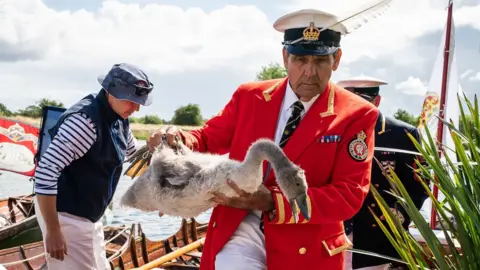 PA Media
PA MediaThe quirky and colourful royal tradition of counting swans on the Thames has begun, for the first time under the insignia of King Charles.
But there are fears that this year's "swan upping" will find swan numbers hit hard by avian flu.
The King's Swan Marker, David Barber, says the disease had been "quite disastrous" for the swan population.
This annual swan census started in west London on Monday and will finish in Abingdon in Oxfordshire on Friday.
"Swan upping" feels like an event that would be very appropriate for King Charles, with its mix of heritage, royal ceremony and wildlife conservation.
There is more than a dash of eccentricity too, with the King's Swan Marker literally wearing a feather in his cap.
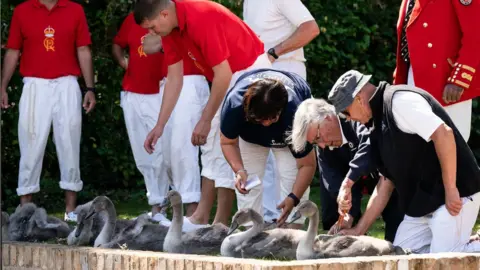 PA Media
PA MediaIn his scarlet jacket, Mr Barber is in charge of a flotilla of small boats that glide up the River Thames, stopping to count, weigh, measure and check the well-being of young swans, called cygnets.
These fluffy grey swans are plucked from the river and put onto the riverbank, where they are checked and tagged, under a barrage of photographs from passers-by.
It's an eye-catching as well as swan-catching sight, with the swan uppers wearing red shirts emblazoned with the new cypher of King Charles and their boats carrying royal flags.
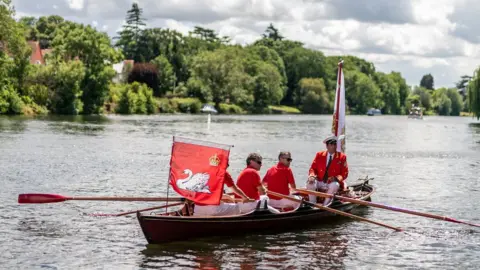 PA Media
PA MediaThe Swan Marker is worried about the impact of avian flu, saying that at the end of last year it was "horrendous, terrible to see", with hundreds of swans lost to the disease.
Mr Barber also worries that if sewage keeps being put into rivers it could harm the swans.
But in the July sunshine, at the start of this annual trip up river, he's able to dispel some swan folklore.
Do they really break people's arms? "It's a myth. They've got powerful wings, but to break a man's arm?"
He says swans will be very protective of their eggs and their young, but he's not convinced about breaking arms.
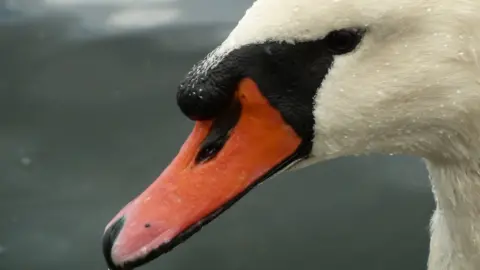
However he thinks the much-repeated story doesn't do any harm in terms of keeping humans away from harming swans.
And do swans really mate for life? Are they nature's template for monogamy?
"They're like humans - some stray away," says the King's Swan Marker, with a wry smile.
Swan upping - so-called says Mr Barber because they go up the river and pick the swans up out of the water - is a traditional summer spectacle on the Thames.
The origins go back to the 12th Century when the Crown claimed ownership of all mute swans, with swans considered a delicacy for medieval banquets.
The Crown still has ownership of unmarked mute swans on open water, such as the Thames, so this counting of swans, now part of conservation work, has its roots in asserting royal rights.
There are also 14th Century claims to shared ownership from the Vintners and Dyers livery companies, whose boats also take part in the counting of swans, with their own flags and outfits.
There's even some history to the boats accompanying the swan uppers, with some of the small craft having been part of the wartime evacuation from the beaches of Dunkirk.
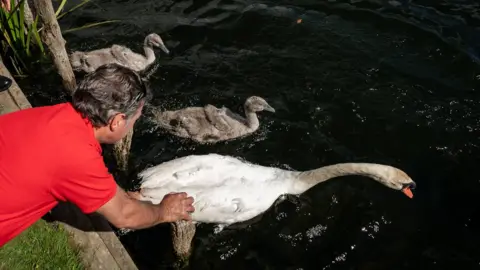 PA Media
PA MediaEven though the swan uppers might be concerned that swan numbers might be on their uppers, there were still families of swans to count, serenely swimming past multi-million pound riverbank homes.
They were nestling in the banks of the river, swimming past moored boats with names like "Ratty and Moley".
The swans themselves seemed understandably surprised to be briefly swept up in this ancient ceremony, but at least they had the relief of being released back into the river, rather than being the centrepiece of a medieval dinner table.
They swam back into the water, a parent patrolling at front and back of their group of cygnets, and they watched with some swan-like superiority as the boats and flags and photographers sailed away and out of sight.
